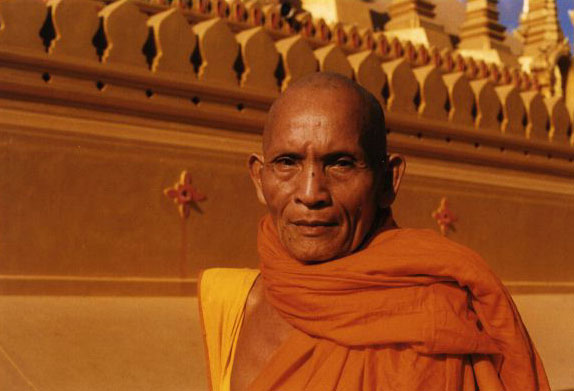 |
| Lao monk, That Luang Festival, Vientiane |
Wednesday, November 12
Visiting Vientiane
I awoke around 7am with the calls of roosters from across the road. Downstairs, no one was up except Joey the brown boxer and his little poodle friend. The two of them pounced on me as soon as I sat down. Alan came out of his bedroom 30 minutes later, wearing only a sarong around his waste. I saw several Thais walking down the road wearing a similar sarong get-up, but in Alan's case, to me he was just a guy in a towel. He pulled out the visa paperwork for us to fill out. We paid him the fee for the visa and caught a tuk-tuk to the Nong Khai bus terminal at 8am. We soon climbed into a minibus to take us over the Friendship Bridge, which spans the Mekong River separating Thailand and Laos. After stopping at a Thai border checkpoint to get our passports stamped, we crossed the bridge into the Lao People's Democratic Republic. The road's pavement shifted from flat and smooth to cracked asphalt as we reached the Lao side of the bridge. At the Lao immigration checkpoint a travel agent who worked for Alan took our papers and passports through the various steps required for entering this small, isolated communist country. Susanne and I leaned against a railing and waited. Once our passports received the proper stamps and papers, we climbed into a jumbo
to the Nong Khai bus terminal at 8am. We soon climbed into a minibus to take us over the Friendship Bridge, which spans the Mekong River separating Thailand and Laos. After stopping at a Thai border checkpoint to get our passports stamped, we crossed the bridge into the Lao People's Democratic Republic. The road's pavement shifted from flat and smooth to cracked asphalt as we reached the Lao side of the bridge. At the Lao immigration checkpoint a travel agent who worked for Alan took our papers and passports through the various steps required for entering this small, isolated communist country. Susanne and I leaned against a railing and waited. Once our passports received the proper stamps and papers, we climbed into a jumbo - the Lao version of a tuk-tuk - and began the 30-minute ride to the capital city of Vientiane.
- the Lao version of a tuk-tuk - and began the 30-minute ride to the capital city of Vientiane.
As we approached Vientiane, I expected the light flow of traffic to increase, but even inside the city limits there weren't that many vehicles about. Vientiane has a population of less than 150,000 people, so it manages to retain a sleepy, colonial atmosphere. The roads were terribly dusty, but besides that it seemed like we were coming to a fairly pleasant place. People smiled at us as they rode by on motorcycles and jumbos. I could see the Mekong through some trees on my left as we approached our day's residence, the Lao Paris Hotel. From the outside, the Lao Paris looked like any other poorly whitewashed guesthouse. Inside, though, we found a sparkling wooden lodge covered in freshly polished teak paneling. It felt like a Swiss mountain resort. The man at the check-in desk gave us a nice room with a/c, a refrigerator, and the hottest shower in Laos for $20, though I could pay in Thai baht or Lao kip if I preferred. We dropped off our bags, changed some money into kip (at 1704 kip per dollar, about 700 kip better than the last exchange rate I had heard in the US) and headed out for a walk through the city.
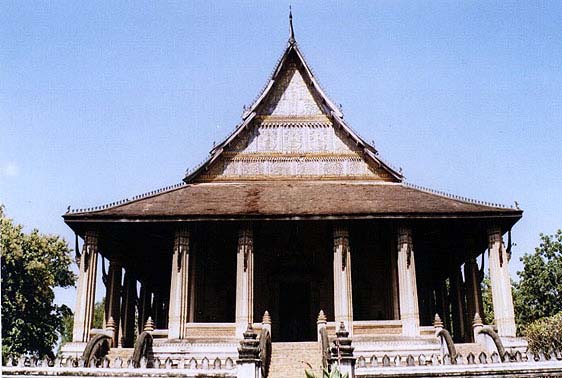 |
| Wat Si Saket, Vientiane |
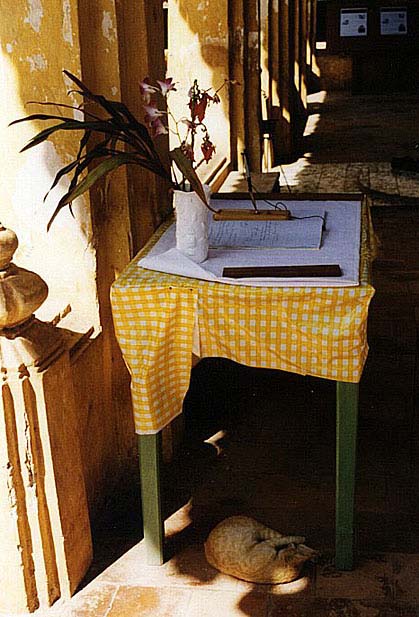 |
| Guardian of the Wat Si Saket Guestbook |
Our first stop was Wat Si Saket, a rustic old monastery across from the presidential palace, about 10 minutes from the hotel. Wat Si Saket has stood since 1818, making it the oldest wat in the entire city. Most of Vientiane's buildings and temples were razed by the Thais during their 1828 sacking of the capital but they spared Si Saket because it was built in a Bangkok style, which they apparently appreciated. There were a couple of German tourists inside the wat, but apart from them we had the entire monastery to ourselves. Its inner courtyard contained scores of sitting Buddha statues as well as several thousand thumb-sized Buddha amulets set in niches along the wall. A Chinese tour group, all sporting light blue pajamas, entered the monastery and walked the perimeter of the wat's sim
in the entire city. Most of Vientiane's buildings and temples were razed by the Thais during their 1828 sacking of the capital but they spared Si Saket because it was built in a Bangkok style, which they apparently appreciated. There were a couple of German tourists inside the wat, but apart from them we had the entire monastery to ourselves. Its inner courtyard contained scores of sitting Buddha statues as well as several thousand thumb-sized Buddha amulets set in niches along the wall. A Chinese tour group, all sporting light blue pajamas, entered the monastery and walked the perimeter of the wat's sim , stopping for pictures and lighting incense along the way. A small cat dozed below a wooden table with an open guest book on top. I thought it was ironic that the cat had chosen to sleep under the one place where each visitor was expected to sign in. I guess they don't get many visitors around here. Didn't look like anyone minded, either. This was Laos - you're welcome to visit, just don't mind us while we nap.
, stopping for pictures and lighting incense along the way. A small cat dozed below a wooden table with an open guest book on top. I thought it was ironic that the cat had chosen to sleep under the one place where each visitor was expected to sign in. I guess they don't get many visitors around here. Didn't look like anyone minded, either. This was Laos - you're welcome to visit, just don't mind us while we nap.
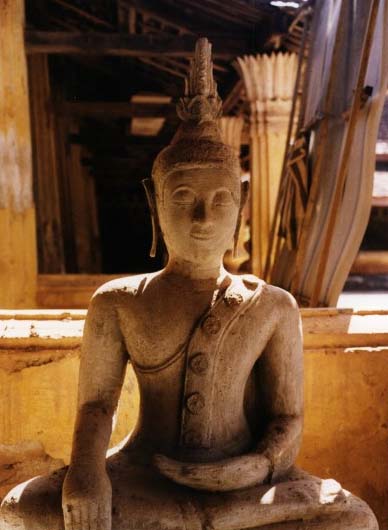 |
| One of the many Buddha images of Vientiane |
Across the street, just to the left of the presidential palace, we entered Wat Pha Kaew, formerly Vientiane's royal monastery. The wat was built in the mid-16th century and for several generations it held the ever-wandering Emerald Buddha statue that has resided in Thailand since 1779. In 1828 the temple was destroyed by the Thais and it wasn't rebuilt until the late 1930s. Particular attention was paid to the carving of its rococo walls, which were still in excellent condition. As with Wat Si Saket, you could argue that Wat Pha Kaew was in need of a thorough dusting and a paint job, but in all honesty, I enjoyed its antique character. While the wats of Bangkok were exquisite they also exuded a Disneyesque quality - every stupa, every garden, every roof was immaculate, bright and polished. Here in Vientiane, I could sense an aged presence in these wats. They were no longer the fresh young temples they once may have been, yet they still possessed a wise, reserved dignity that seemed to be lacking elsewhere. Like the Lao people, the wats didn't feel a need to be flamboyant or over-the-top. Simplicity was the key here.
Two monks with instant cameras posed for each other in front of the main sim. We took off our shoes and mounted the temple platform. Several dozen bronze sitting Buddhas dating back as far as the 15th century stood guard around the platform, facing away from the inner sim. Sun reflected off of the eyes of the Buddhas, many of which were fashioned with semi-precious stones. The Chinese tourists we had seen at Wat Si Saket then arrived, and they made their way clockwise along the platform. As they reached each sitting Buddha they performed a wai - the traditional greeting of respect, their hands in a prayer position and their torso leaning forward modestly.
It was now around lunchtime and all the wats would be closed until 2pm, so we walked down Thanon Fa Ngum, Vientiane's boulevard along the Mekong. We stopped for an hour at the Mixay Cafe, a popular outdoor restaurant with shady trees, a good view, and refreshingly cool breeze from the river. We split a couple of rice dishes, one fried and the other a basket of sticky rice, the translucent gelatinous rice popular among the Lao. Susanne looked a bit tired and worn from the hectic pace of Cambodia and our long travel day, so we returned to the hotel so she could nap and I could shower. The bathroom looked recently tiled and the water was scalding hot - I could have stayed there all afternoon.
Around 2pm we walked to Talaat Sao, the morning market, which actually remains open until 6pm each day. Susanne was suffering from chronic indigestion so we found a pharmacy beyond the eastern side of the market and bought some plastic pouches of Maalox. We then caught a five minute jumbo ride to Pha That Luang, Laos' greatest monumental treasure. First built in 1565, That Luang is a 150-foot golden stupa surrounded by several dozen gilded spires, and for centuries has served as a major pilgrimage site for Lao Buddhists. And since the time of independence from France, That Luang has represented Lao nationalism and unity - its image can be seen on much of the currency today.
surrounded by several dozen gilded spires, and for centuries has served as a major pilgrimage site for Lao Buddhists. And since the time of independence from France, That Luang has represented Lao nationalism and unity - its image can be seen on much of the currency today.
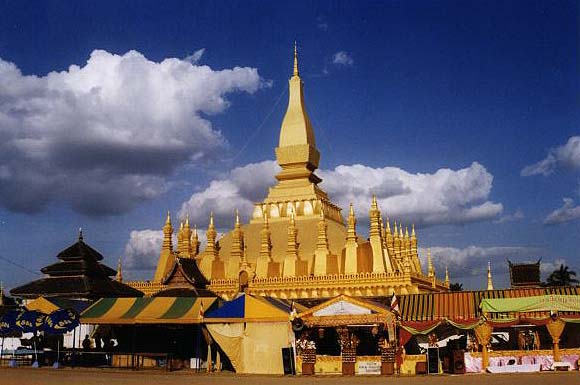 |
| That Luang, Vientiane |
This particular week also happened to be the annual That Luang festival, when Buddhist monks from all over southeast Asia gather at the stupa to celebrate the November full moon and the completion of the annual monsoon rains. On the evening of the full moon, about two nights from now, there will be a sacred procession by all of the monks, followed by an evening of fireworks and all-out revelry. Until then, the stupa will play host to a convention of sorts, where hundreds of monks of all ages camp out in the surrounding courtyard. It reminded me of the annual convergence of Boy Scouts on Washington DC, except in Laos the boys wore saffron robes instead of khaki uniforms and socks pulled up to their knees. There's a carnival-like atmosphere outside, where vendors have set up an entire market of goods and amusements.
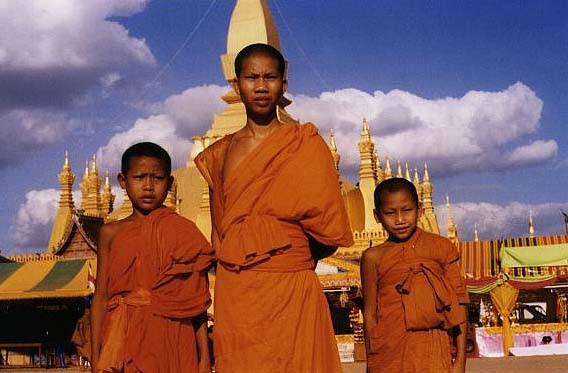 |
| Three novice monks visiting That Luang, Vientiane |
That Luang gives off a blinding reflection as the sun bounces off its golden surface, regilded in 1995 to commemorate the 20th anniversary of the Pathet Lao's proclamation of the Lao People's Democratic Republic. We paid our 200 kip entrance fee (about 12 cents) and entered the main courtyard. Loudspeakers beamed the voice of a Lao gentleman speaking in a continuous drone. At first I thought it was a monk's chant or perhaps communist propaganda, but then I heard him pause and give out a hearty belly laugh, as if he had just told us a joke or something. The more I listened, the more the man sounded like he was a radio DJ giving an on-location broadcast, though I still have no idea what on earth he was talking about.
The four stairwells that led up to the higher platforms of the stupa were obstructed by shrines of flowers and candles which grew steadily as more visitors arrived with offerings. But because the platforms were closed off, our only view of the stupa had to be from ground level. We walked clockwise around the stupa in the hot afternoon sun. Hundreds of novice monks were camping out in the shade along the perimeter of the inner courtyard. Some of the young boys tried to catch some ZZZ's while the others played cards, brushed their teeth, read a book, or horsed around with friends. Some stared at us; I began to feel rather obtrusive. If this were a convention of sorts, it seemed like I was stalking the hotel hallways prying through open doors. "So you wanted to take pictures of monks," I said to Susanne. " Here's your lucky chance." Actually, it wasn't the finest opportunity since the monks were all preoccupied with the festival. A few of the adolescent novices paused and let us take their pictures, but most of them had a "can't you see I'm busy?" look on their faces. Perhaps it was best to leave them alone instead.
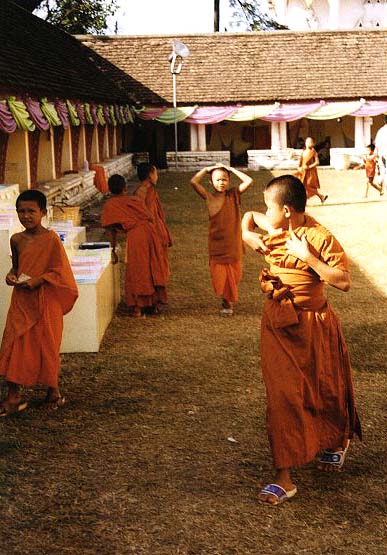 |
| Novices having fun at the That Luang Festival |
I sat in a shady corner of the courtyard, enjoying the breeze and the grand view of stupa as monks and novices walked about. Susanne vanished around the other side of the stupa, probably to take some pictures. We soaked up the atmosphere for a while and eventually headed outside to visit the market. Loudspeakers played Lao pop music while vendors fried Chinese donuts and invited young novices to play a game of ring toss: get the ring around a bottle of Pepsi, get the bottle of Pepsi. We caught a jumbo back to the hotel, where we tried to write in our journals downstairs, but the hotel TV was blasting MTV at full volume, making it impossible to concentrate. The room didn't have a proper writing desk so we walked down the street to a brand new four-star hotel. We sat in its cafe drinking coffee and Sprite as we wrote for at least two hours. The cafe's PA system quietly played the greatest hits of Zamfir on the pan flute, on which he covers hits by the Beatles, Frank Sinatra, and showtune standards. Somehow we managed to focus on our journals despite breaking out into fits of laughter at the beginning of almost every song.
Back at the hotel we had a late dinner of lemongrass soup, rice and "Lao Baked Chicken," a plate of cut up chicken bones, each holding a gram or two of meat. I stopped trying to pick at it when I realized I was holding a complete chicken foot in my hand. At least the soup was tasty.

 to the Nong Khai bus terminal at 8am. We soon climbed into a minibus to take us over the Friendship Bridge, which spans the Mekong River separating Thailand and Laos. After stopping at a Thai border checkpoint to get our passports stamped, we crossed the bridge into the Lao People's Democratic Republic. The road's pavement shifted from flat and smooth to cracked asphalt as we reached the Lao side of the bridge. At the Lao immigration checkpoint a travel agent who worked for Alan took our papers and passports through the various steps required for entering this small, isolated communist country. Susanne and I leaned against a railing and waited. Once our passports received the proper stamps and papers, we climbed into a jumbo
to the Nong Khai bus terminal at 8am. We soon climbed into a minibus to take us over the Friendship Bridge, which spans the Mekong River separating Thailand and Laos. After stopping at a Thai border checkpoint to get our passports stamped, we crossed the bridge into the Lao People's Democratic Republic. The road's pavement shifted from flat and smooth to cracked asphalt as we reached the Lao side of the bridge. At the Lao immigration checkpoint a travel agent who worked for Alan took our papers and passports through the various steps required for entering this small, isolated communist country. Susanne and I leaned against a railing and waited. Once our passports received the proper stamps and papers, we climbed into a jumbo - the Lao version of a tuk-tuk - and began the 30-minute ride to the capital city of Vientiane.
- the Lao version of a tuk-tuk - and began the 30-minute ride to the capital city of Vientiane. 




